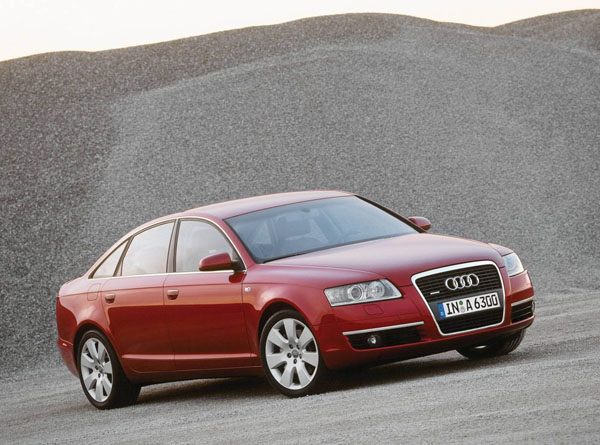
Audi A6 is a medium-large car much loved by those who like a solid touch of sportiness in their transport. As well as the standard A6 models, Audi also sells a good range of high-performance versions. Called, in ascending order, Audi A6 S Line, Audi S6 and Audi RS6, they provide stunning performance in topline guise. These sportier models give a halo effect throughout the complete range.
Audi is highly regarded in Australia these days, something that wasn’t the case when rivals Mercedes-Benz and BMW ruled the roost. That was despite the fact that Audi holds equal ranking in most European countries.
The so-called single-frame grille, with its huge central area, has been a stroke of genius in automotive design, one that’s been copied by just about every other stylist. Indeed BeEm and Merc grilles have grown significantly in recent years. In Australia aggressive marketing has been added to Audi’s style and the two factors have played a major part in the resurgence downunder.
The A6 replaced the Audi 100 in November 1994, but struggled in the sales race in its early days. A virtually all-new A6 that reached Australia in November 1997 improved things somewhat so we will start looking in detail at the A6 from that model onwards.
Interior design and quality have been strong points in Audis for many years and the cabin is close to immaculate in the way it’s themed and then constructed.
Interior space is OK for five adults, though lack of support in the centre-rear position makes it a noticeably less comfortable position than the other seats. The Audi A6 has high levels of noise, vibration and harshness suppression that make it a very capable high-speed cruiser.
Boot space is very good in the sedan. Audi A6 has a reasonably strong presence in the prestige station wagon market in Australia, though not to the huge extent it does on its home market. If you’ve ever driven in Germany you will have been amazed at the number of times you’ve been overtaken by Audi station wagons travelling at warp speed. Great fun.
An interesting variant is the Allroad Quattro, an all-wheel-drive station with increased ground clearance and added body protection panels. It’s not what you would call an SUV, but is capable in soft, even medium, off the beaten track work.
Handling is better than average for a front-wheel-drive car, though the powertrain layout, with the engine being mostly in front of the axle, means the nose-heavy machine tends to push slightly wide on corners. This has been toned down with each successive model, but is still a weak point compared with other vehicles in this upmarket German class.
Owners who are more interested in calm, quiet cruising are unlikely to ever experience the understeer even in the older models.
There is the option of Audi’s famous quattro all-wheel-drive system for added traction on slippery roads. It too can suffer from front-end push but does so at higher cornering efforts. Quattro isn’t on offer in all models, but is well worth the extra money if you’re a keen driver.
Engines come in a staggering range, with petrol and diesel units on offer. In the petrol line-up there’s everything from 2.0-litre four-cylinder units through V6s with capacities of 2.4, 2.6, 2.7, 2.8, 3.0 and 3.2 litres. Some are turbocharged, others supercharged, and there are naturally-aspirated units.
Then there are the turbo-diesel engines, fours and V6s, ranging from 2.0 litres, through 2.7 litres, to 3.0 litres.
Rather than filling the rest of this feature with details of which engine is offered in which model over which time period may we suggest you contact your local Audi dealer?
These big Audis are complex vehicles and it’s best that you have all work, other than the vary basics of servicing, done professionally. Audi dealers are generally restricted to major metropolitan areas but you will find some in major country centres as well. Contact Audi’s head office in Sydney for further information.
Insurance costs are relatively high, but no more than you would expect from high-quality cars built from top-end materials. Premiums don’t usually vary a lot between major players, but it’s always worth shopping around for the best deal. Make sure you are comparing like with like before making your decision.
WHAT TO LOOK FOR
Rust is rare as Audi has used galvanised or aluminium panels in its bodies for many years. Poor crash repairs which didn’t see the metal being properly protected can still lead to troubles.
Sun damage, even on cars that have been kept outside continuously, is rare, but check the upper surfaces of the dashboard as well as the condition of the rear parcel shelf.
Interiors are finished to a very high standard and last well, but careless owners can still cause damage that can be expensive to repair.
Be sure the camshaft drive belt has been replaced on schedule.
Look for oil leaks from early V6 engines.
Check for leaks from the power-steering rack and the hoses connected to it.
Make sure the automatic transmission works smoothly and does not change gears when it shouldn’t. If tiptronic manual overrides are fitted run the transmission up and down through the gears to make sure it selects them quickly.
CAR BUYING TIP
The more expensive the car the more you’re likely to be charged for service, parts and repairs. Don’t fall for the trap of buying an old one for the same price as a brand new car with a more mundane image.